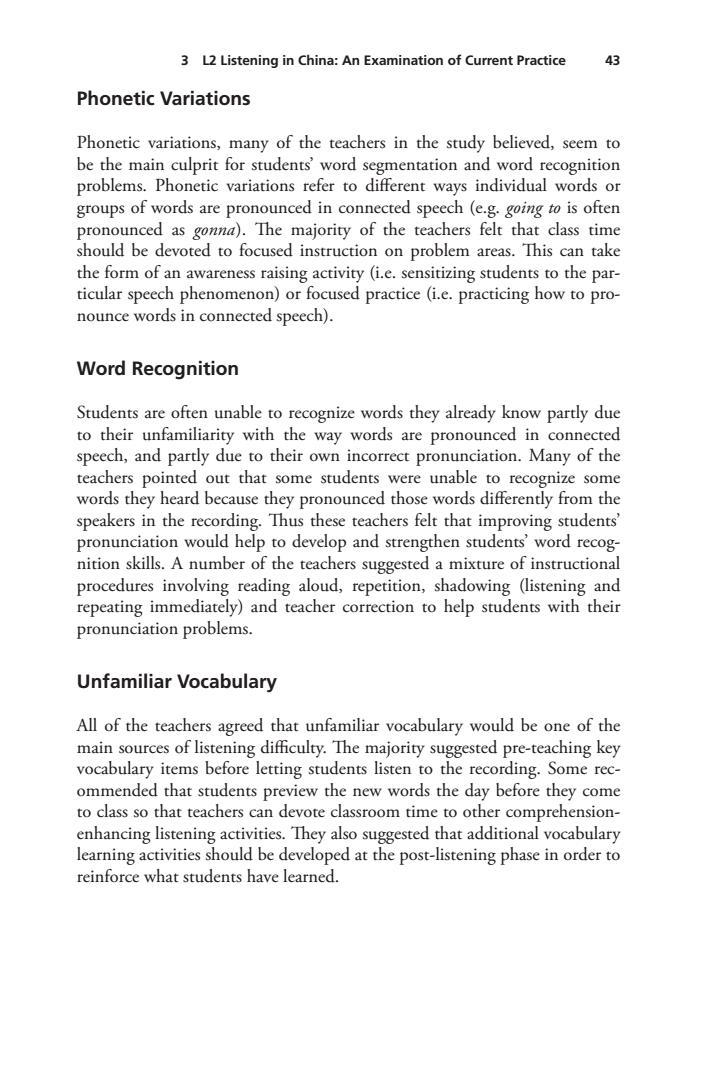正在加载图片...

3 L2 Listening in China:An Examination of Current Practice 43 Phonetic Variations Phonetic variations,many of the teachers in the study believed,seem to be the main culprit for students'word segmentation and word recognition problems.Phonetic variations refer to different ways individual words or groups of words are pronounced in connected speech (e.g.going to is often ue This can take the form of an awareness raising activity (i.e.sensitizing students to the par- ticular speech phenomenon)or focused practice (i.e.practicing how to pro nounce words in connected speech). Word Recognition Students are often unable to recognize words they already know partly due to their unfamiliarity with the way words are pronounced in connected speech,and partly due to their own incorrect pronunciation.Many of the teachers pointed out that some students were unable to recognize some words they heard because they pronounced those words differently from the speakers in the recording.Thus these teachers felt that improving students' pronunciation would help to develop and strengthen students'word recog nition skills.A number of the teachers suggested a mixture of instructional procedures involving reading aloud,repetition,shadowing (listening and repeating immediately)and teacher correction to help students with their pronunciation problems. Unfamiliar Vocabulary All of the teachers agreed that unfamiliar vocabulary would be one of the main soures of listening difficulty.The majority suggested pre-teaching key vocabulary items before letting students listen to the recording.Some rec- ommended that students preview the new words the day before they come to class so that teachers can devote classroom time to other comprehension enhancing listening activities.They also suggested that additional vocabulary learning activities should be developed at the post-listening phase in order to reinforce what students have learned. 3 L2 Listening in China: An Examination of Current Practice 43 Phonetic Variations Phonetic variations, many of the teachers in the study believed, seem to be the main culprit for students’ word segmentation and word recognition problems. Phonetic variations refer to diferent ways individual words or groups of words are pronounced in connected speech (e.g. going to is often pronounced as gonna). Te majority of the teachers felt that class time should be devoted to focused instruction on problem areas. Tis can take the form of an awareness raising activity (i.e. sensitizing students to the particular speech phenomenon) or focused practice (i.e. practicing how to pronounce words in connected speech). Word Recognition Students are often unable to recognize words they already know partly due to their unfamiliarity with the way words are pronounced in connected speech, and partly due to their own incorrect pronunciation. Many of the teachers pointed out that some students were unable to recognize some words they heard because they pronounced those words diferently from the speakers in the recording. Tus these teachers felt that improving students’ pronunciation would help to develop and strengthen students’ word recognition skills. A number of the teachers suggested a mixture of instructional procedures involving reading aloud, repetition, shadowing (listening and repeating immediately) and teacher correction to help students with their pronunciation problems. Unfamiliar Vocabulary All of the teachers agreed that unfamiliar vocabulary would be one of the main sources of listening difculty. Te majority suggested pre-teaching key vocabulary items before letting students listen to the recording. Some recommended that students preview the new words the day before they come to class so that teachers can devote classroom time to other comprehensionenhancing listening activities. Tey also suggested that additional vocabulary learning activities should be developed at the post-listening phase in order to reinforce what students have learned